selected item
Knock on wood: turning biomass into fuel
- The energy transition will require multiple solutions and collaborations.
- ExxonMobil and the National Renewable Energy lab are testing the conversion of wood waste to bio-oil.
- This oil has the potential to be upgraded into a biofuel for the vehicles we drive today.
Making a global impact on climate change isn’t easy. Reducing emissions on a global scale requires multiple solutions, and we believe biofuels can play a big part.
That’s why we’ve been working with the U.S. Department of Energy’s Renewable Energy Laboratory (NREL) to develop technologies that could have a global impact. As part of this collaboration, NREL and ExxonMobil scientists and engineers are testing the potential for converting wood waste to bio-oil. If successful, this oil would have the potential to be upgraded into a biofuel we could use in the cars and trucks we drive every day.
NREL is a world leader in biomass conversion, and we have a long history of moving technologies from the lab to commercial use, including lower-emission fuels. We’re combining our strengths in hopes of developing a solution faster than either of us could do alone.
So far, we’ve successfully completed small, experimental tests, and the next phase is to move to a pilot demonstration soon. The goal of the pilot is to prove the concept works and provide more data to one day move to the commercial phase, and potentially transform transportation.
Hear from more from the experts below:
*Nothing in this material or video is intended to propose, describe, or create, nor shall it be deemed to propose, describe, or create, in law or in equity, any participation by ExxonMobil in a partnership, agency, fiduciary relationship, or joint liability with NREL. The term partnership in the video is merely for convenience and simplicity to connote the research collaboration between ExxonMobil and NREL.
Explore more

The future of seismic imaging and technology
3 min read
• March 13, 2025
A “quantum leap forward”: We’re pioneering a new automation technology that could transform manufacturing

Putting wind lubricants to the test, 33 stories high



